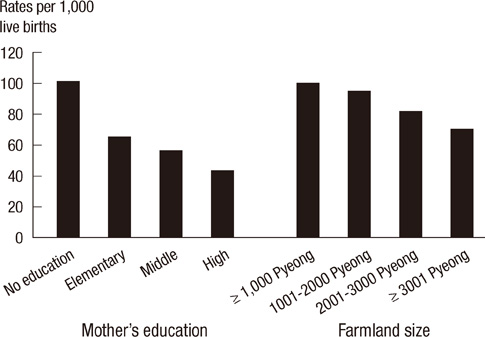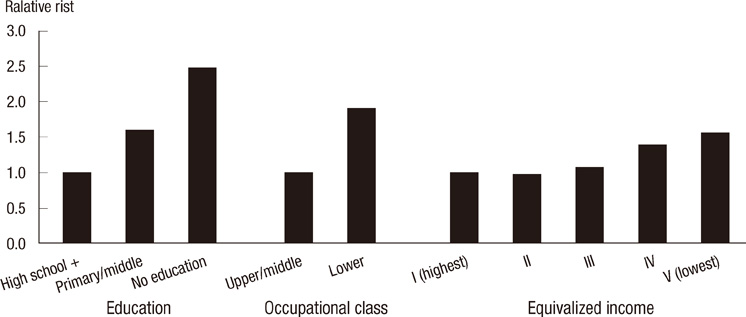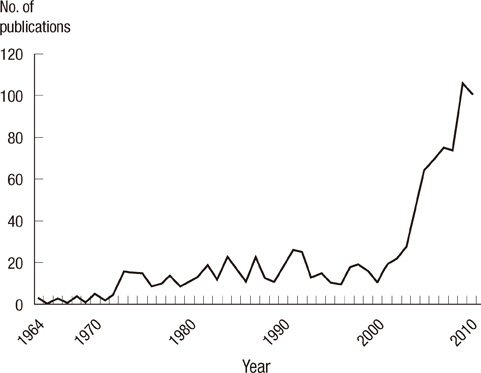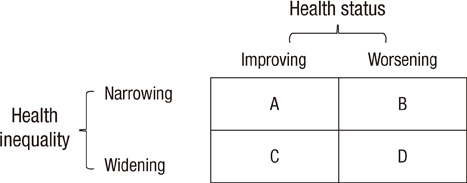Health Inequalities Policy in Korea: Current Status and Future Challenges
- Affiliations
-
- 1Department of Preventive Medicine, University of Ulsan College of Medicine, Seoul, Korea. youngk@amc.seoul.kr
- KMID: 1714486
- DOI: http://doi.org/10.3346/jkms.2012.27.S.S33
Abstract
- In recent years, health inequalities have become an important public health concern and the subject of both research and policy attention in Korea. Government reports, as well as many epidemiological studies, have provided evidence that a wide range of health outcomes and health-related behaviors are socioeconomically patterned, and that the magnitude of health inequalities is even increasing. However, except for the revised Health Plan 2010 targets for health equity, few government policies have explicitly addressed health inequalities. Although a number of economic and social policies may have had an impact on health inequalities, such impact has scarcely been evaluated. In this review, we describe the current status of research and policy on health inequalities in Korea. We also suggest future challenges of approaches and policies to reduce health inequalities and highlight the active and intensive engagement of many policy sectors and good evidence for interventions that will make meaningful reduction of health inequalities possible.
Keyword
Figure
Cited by 3 articles
-
Socioeconomic inequalities in health risk factors in Korea
Yu-Mi Kim, Kyunghee Jung-Choi
J Korean Med Assoc. 2013;56(3):175-183. doi: 10.5124/jkma.2013.56.3.175.Current status of policy developments in tackling health inequalities and the next steps to be taken in Korea
Myoung-Hee Kim, Joohee Lee
J Korean Med Assoc. 2013;56(3):206-212. doi: 10.5124/jkma.2013.56.3.206.The Prevalence and Emergency Department Utilization of Patients Who Underwent Single and Double Inter-hospital Transfers in the Emergency Department: a Nationwide Population-based Study in Korea, 2016–2018
Youn-Jung Kim, Jung Seok Hong, Seok-In Hong, June-Sung Kim, Dong-Woo Seo, Ryeok Ahn, Jinwoo Jeong, Sung Woo Lee, Sungwoo Moon, Won Young Kim
J Korean Med Sci. 2021;36(25):e172. doi: 10.3346/jkms.2021.36.e172.
Reference
-
1. CSDH (Commission on Social Determinants of Health). Closing the gap in a generation: health equity through action on the social determinants of health. Final report of the commission on social determinants of health. 2008. Geneva: WHO.2. Ministry of Health and Welfare and Korea Centers for Disease Control and Prevention. 2009 Nation's Health Statistics: findings of Korea national health and nutrition examination survey IV-3 (2009). 2010. Seoul: Ministry of Health and Welfare and Korea Centers for Disease Control and Prevention.3. Kim YM, Kim MH. Health inequalities in Korea: current conditions and implications. J Prev Med Public Health. 2007. 40:431–438.4. Statistics Korea. Korean Statistical Information Service. accessed on 2 May 2011. Available at http://kosis.kr/.5. World Bank. The East Asian Miracle: economic growth and public policy. 1993. New York: Oxford University Press.6. Khang YH, Lynch J. Asian economic crises and health: population health impacts and policy responses. J Epidemiol Community Health. 2010. 64:282–283.7. Kim IH, Muntaner C, Khang YH, Paek DM, Cho SI. The relationship between nonstandard working and mental health in a representative sample of the South Korean population. Soc Sci Med. 2006. 63:566–574.8. Kim MH, Kim CY, Park JK, Kawachi I. Is precarious employment damaging to self-rated health? Results of propensity score matching methods, using longitudinal data in South Korea. Soc Sci Med. 2008. 67:1982–1994.9. Choo H. Economic growth and income distribution in Korea. 1978. Seoul: Korea Development Institute.10. Suh SM. Economic growth and change in income distribution: the Korean case. 1985. Seoul: Korea Development Institute.11. Park HJ. A study on infant deaths in Korean rural area. Seoul J Med. 1962. 3:41–51.12. Population Division of the Department of Economic and Social Affairs of the United Nations Secretariat. World population prospects: the 2006 revision and world urbanization prospects: the 2007 revision. accessed on 4 May 2011. Available at http://esa.un.org/unup.13. Kwon TH. The trends and patterns of mortality and health in the Republic of Korea. Asian population studies series. No. 76. 1986. Bankok: Economic and Social Commission for Asia and the Pacific.14. Kim TH. Mortality transition in Korea: 1960-1980. 1990. Seoul: Seoul National University, The Population and Development Studies Center.15. Khang YH, Lynch JW, Harper S, Yang S, Yun SC, Jung-Choi K, Kim HR. The contribution of material, psychosocial, and behavioral factors to explain educational and occupational mortality inequalities in a nationally representative sample of South Koreans: relative and absolute perspectives. Soc Sci Med. 2009. 68:858–866.16. Mackenbach JP, Stirbu I, Roskam AJ, Schaap MM, Menvielle G, Leinsalu M, Kunst AE. European Union Working Group on Socioeconomic Inequalities in Health. Socioeconomic inequalities in health in 22 European countries. N Engl J Med. 2008. 358:2468–2481.17. Regidor E, Ronda E, Pascual C, Martínez D, Calle ME, Domínguez V. Decreasing socioeconomic inequalities and increasing health inequalities in Spain: a case study. Am J Public Health. 2006. 96:102–108.18. Blakely T, Wilson N. Shifting dollars, saving lives: What might happen to mortality rates, and socio-economic inequalities in mortality rates, if income was redistributed. Soc Sci Med. 2006. 62:2024–2034.19. Deaton A. Policy implications of the gradient of health and wealth. Health Aff (Millwood). 2002. 21:13–30.20. Starfield B, Birn AE. Income redistribution is not enough: income inequality, social welfare programs, and achieving equity in health. J Epidemiol Community Health. 2007. 61:1038–1041.21. Khang YH. Historical advances in health inequality research. J Prev Med Public Health. 2007. 40:422–430.22. Khang YH. Lifecourse approaches to socioeconomic health inequalities. J Prev Med Public Health. 2005. 38:267–275.23. Son M. Commentary: why the educational effect is so strong in differentials of mortality in Korea? Int J Epidemiol. 2004. 33:308–310.24. Jung-Choi KH. Contribution of causes of death to socioeconomic mortality inequalities: current status and time trends in Korea [dissertation]. 2008. Seoul: University of Ulsan.25. Khang YH, Kang MA, Kim MH, Kim YM, Shin YJ, Yoo WS, Yoon TH, Jang SN, Jeong BG, Jungchoi KH, Cho SI, Cho HJ, Choi YE, Choi YJ, Heo SI. Developing indicators of equity in health and monitoring magnitude of socioeconomic inequalities in health. 2006. Seoul: University of Ulsan & Management Center for Health Promotion.26. Kwon SM, Son M, Lee EJ, Cho SI, Cho YT, Ku MJ, Kim YH, Oh J, Chung HJ. Developing performance indicators of equity in health. 2006. Seoul: Seoul National University & Management Center for Health Promotion.27. Shin YJ, Kim MH, Yoon TH. Health promotion strategies and programmes development for health inequalities alleviation. 2009. Seoul: Hanyang University & Management Center for Health Promotion.28. Son M, Kim SJ, Lee JH, Kim JO, Bae SH, Oh JH, Hwang SS, Kim YJ, Jung SM, Lee WJ, Lee SY, Park JH, Park JH, Lim DO, Park IS, Yoon CK. Reducing inequalities in cancer incidence and mortality: developing epidemiologic health inequality index and health policy in Korea. 2008. Seoul: Kangwon National University & Ministry of Health and Welfare.29. Kaplan GA, Lynch JW. Whither studies on the socioeconomic foundations of population health? Am J Public Health. 1997. 87:1409–1411.30. The Korean Society for Equity in Health. Methods in health inequalities measurement. 2007. Seoul: Hanul Publishing Group.31. Lee SY, Kim SY, Kim CW, Park HK, Yoon TH, Kim JH. Inequality on medical service utilization among stroke patients across income groups. 2007. Seoul: Cheju National University & Management Center for Health Promotion.32. Kim HR, Khang YH, Yoon KJ, Kim CS. Socioeconomic health inequalities and counter policies in Korea. 2004. Seoul: Korea Institute for Health and Social Affairs.33. Kim MH, Seo JH, Son JI, Cho HJ, Choi YJ. PHI health equity report 2010. Anti-smoking policies and health inequalities in Korea. 2004. Seoul: People's Health Institute.34. Cho HJ. Mortality differentials of government officers and private school teachers by social stratification in Korea [dissertation]. 1997. Seoul: Seoul National University.35. Kim CW, Lee SY, Moon OR. Inequalities in cancer incidence and mortality across income groups and policy implications in South Korea. Public Health. 2008. 122:229–236.36. Kim HR, Khang YH, Park EJ, Choi JS, Lee YH, Kim YS. Socioeconomic, behavioral, nutritional, and biological determinants of morbidity, mortality, and medical utilization in South Korea. 2006. Seoul: Korea Institute for Health and Welfare.37. Song YM, Ferrer RL, Cho SI, Sung J, Ebrahim S, Davey Smith G. Socioeconomic status and cardiovascular disease among men: the Korean national health service prospective cohort study. Am J Public Health. 2006. 96:152–159.38. Yim J, Hwang SS, Yoo KY, Kim CY. Contribution of income-related inequality and healthcare utilisation to survival in cancers of the lung, liver, stomach and colon. J Epidemiol Community Health. 2012. 66:37–40.39. Yoon TH, Lee SY, Kim CW, Kim SY, Jeong BG, Park HK. Inequalities in medical care utilization by South Korean cancer patients according to income: a retrospective cohort study. Int J Health Serv. 2011. 41:51–66.40. Jang SN, Cho SI, Chang J, Boo K, Shin HG, Lee H, Berkman LF. Employment status and depressive symptoms in Koreans: results from a baseline survey of the Korean Longitudinal Study of Aging. J Gerontol B Psychol Sci Soc Sci. 2009. 64:677–683.41. Seo JH, Kim H, Shin YJ. Analysis for the impact of adulthood and childhood socioeconomic positions and intergenerational social mobility on adulthood health. J Prev Med Public Health. 2010. 43:138–150.42. Khang YH, Lynch JW, Kaplan GA. Health inequalities in Korea: age- and sex-specific educational differences in the 10 leading causes of death. Int J Epidemiol. 2004. 33:299–308.43. Yang S, Khang YH, Harper S, Davey Smith G, Leon D, Lynch J. Understanding rapid increase in life expectancy in Korea. Am J Public Health. 2010. 100:896–903.44. Bae JY. Impacts of health insurance coverage expansion on healthcare utilization and health status [dissertation]. 2009. Seoul: Seoul National University.45. Khang YH, Lynch JW, Yun S, Lee SI. Trends in socioeconomic health inequalities in Korea: use of mortality and morbidity measures. J Epidemiol Community Health. 2004. 58:308–314.46. Lee WY, Khang YH, Noh M, Ryu JI, Son M, Hong YP. Trends in educational differentials in suicide mortality beforebetween 1993-2006 in Korea. Yonsei Med J. 2009. 50:482–492.47. Khang YH, Hwang IA, Yun SC, Jo MW, Lee MJ, Lee MS, Lee SI. Changes in mortality inequality in relation to the South Korea economic crisis: use of area-based socioeconomic position. J Prev Med Public Health. 2005. 38:359–365.48. Kim MH, Jung-Choi K, Jun HJ, Kawachi I. Socioeconomic inequalities in suicidal ideation, parasuicides, and completed suicides in South Korea. Soc Sci Med. 2010. 70:1254–1261.49. Son M. The effects of the parents' social class on the low birthweight among the births, 1995-2001. Korean J Health Policy Adm. 2004. 14:148–168.50. Lee CG. Tracking health inequalities in Korea. Reports for agenda setting. 2007. Seoul: Mim Books.51. Ministry of Health and Welfare and Korea Institute for Health and Social Affairs. Establish of new health plan 2010. 2005. Seoul: Ministry of Health and Welfare and Korea Institute for Health and Social Affairs;42–46. 88352. Ministry of Health and Welfare. The national health plan 2020. 2011. Seoul: Ministry of Health and Welfare.53. Yoon TH. The proposal of policies aimed at tackling health inequalities in Korea. J Prev Med Public Health. 2007. 40:447–453.54. Whitehead M. Diffusion of ideas on social inequalities in health: a European perspective. Milbank Q. 1998. 76:469–492. 30655. Mackenbach JP, Bakker MJ. European Network on Interventions and Policies to Reduce Inequalities in Health. Tackling socioeconomic inequalities in health: analysis of European experiences. Lancet. 2003. 362:1409–1414.56. Mackenbach JP, Bakker M, editors. Reducing inequalities in health. A European perspective. 2002. London: Routledge.57. The Marmot Review. Fair society, healthy lives. 2010. London: UK Department of Health.58. European Review on the Social Determinants of Health and the Health Divide. accessed on 11 May 2011. Available at http://www.marmotreview.org/european-review-of-hi/description.aspx.59. Heckman JJ. Skill formation and the economics of investing in disadvantaged children. Science. 2006. 312:1900–1902.60. Cunha F, Heckman JJ. The economics and psychology of inequality and human development. J Eur Econ Assoc. 2009. 7:320–364.61. UK Department of Education. Every child matters. 2003. London: UK Department of Education.62. UK Department of Children, Schools, and Families and UK Department of Health. Healthy lives, brighter futures. 2009. London: UK Department of Children, Schools, and Families and UK Department of Health.63. Australian Government. Investing in the early years: a national early childhood development strategy. An initiative of the council of Australian governments. 2009. ACT, Australia: Australian Government.64. Kim MH, Kim IA, Park YJ, Park JW, Son JI, Lee SI, Jung MS. A report on the calculation of the minimum income for hHealthy living in Korea. accessed on 11 May 2011. Available at http://www.healthequity.or.kr/.65. Khang YH, Lynch JW, Jung-Choi KH, Cho HJ. Explaining age specific inequalities in mortality from all causes, cardiovascular disease and ischaemic heart disease among South Korean male public servants: relative and absolute perspectives. Heart. 2008. 94:75–82.66. Cho HJ, Song YM, Smith GD, Ebrahim S. Trends in socio-economic differentials in cigarette smoking behaviour between 1990 and 1998: a large prospective study in Korean men. Public Health. 2004. 118:553–558.67. Khang YH, Cho HJ. Socioeconomic inequality in cigarette smoking: trends by gender, age, and socioeconomic position in South Korea, 1989-2003. Prev Med. 2006. 42:415–422.68. Khang YH, Yun SC, Jung-Choi K, Cho HJ. The impact of governmental anti-smoking policy on socioeconomic disparities in cigarette smoking in South Korea. Nicotine Tob Res. 2009. 11:262–269.69. Kim HR. Socioeconomic inequality and its trends in cigarette smoking in South Korea, 1998-2005. Health Soc Welf Rev. 2007. 27:25–43.70. Macintyre S. Good intentions and received wisdom are not good enough: the need for controlled trials in public health. J Epidemiol Community Health. 2010. 65:564–567.
- Full Text Links
- Actions
-
Cited
- CITED
-
- Close
- Share
- Similar articles
-
- Current status of policy developments in tackling health inequalities and the next steps to be taken in Korea
- Socioeconomic inequalities in health status in Korea
- The Proposal of Policies Aimed at Tackling Health Inequalities in Korea
- Health Inequalities in Korea: Current Conditions and Implications
- Health in All Policies: The Evolution of Health Promotion and Intersectoral Cooperation






